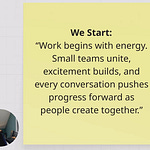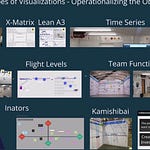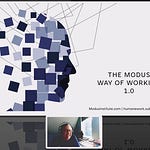A Modus Model Monday Post
Work keeps surprising you by taking too long.
You can write it off to interruptions, to things "not being explained right"… but it's time to embrace the complexity and build systems that help you see it coming.
Hofstadter's Law Hurts
"It always takes longer than you expect, even when you take into account Hofstadter's Law."
Douglas Hofstadter said this haunting quote way back in 1979. And it's been steadfastly ignored by anyone who has tried to estimate work ever since. It looks like this is about estimation and time, because when we estimate we ask ourselves, "How much time should this take?"
The cruel fact is, this isn't about time at all. It's about complexity…the kind of work where the solution emerges as you do it, where each step reveals new steps you didn't know existed. Complexity makes you yell "why doesn't this work?" "Why isn't this done yet?" As unexpected issues arise, as things don't work as we expect, we fall victim to complexity.
We don’t need to be victims.
Weird Work in the Now
For solopreneurs, remote workers, and anyone attached to distributed teams, we don't have someone to tap on the shoulder when you discover that "simple" client request actually requires learning three new tools, navigating two different bickering teams, and somehow making them all play nicely with the meeting invites you are sending out. It can feel like you are on your own with the "surprise" complexity, and your client is wondering why the two-hour task is now on day three.
But the problem here isn't the extra time…it's that you don't even know it's complexity. You might blame yourself for the estimate. You might blame an app or someone else for "slowing you down." But the fact is complexity exists, sometimes we can see it, sometimes we can't. But it always happens.
When we and our colleagues/clients don't respect this, we deal with broken trust. With yourself, with your client, with your team. When you consistently underestimate, you start to feel incompetent, even when you're doing brilliant work solving problems you couldn't have planned for.
Or is that true?
How You Can Plan for Complexity
You can plan for them. You know they are coming. So what can we do to make sure they are part of the work and not a crisis?
The answer is not better estimation. The answer is making complexity visible so you can manage it rather than be blindsided by it.
AI as Complexity Detector (Not Eliminator, and not Immune from it Either)
AI promises to help and sometimes it delivers. AI can break down complex tasks, research solutions faster, and generate starting points when you're stuck in that "how do I even approach this?" moment. I will create plans, make them detailed, but also tell the stories of why the work is necessary, who is asking for it and what I think might get in my way.
Give that to an AI agent (of any complexity) and prompt it something like. “What am I missing?” “Where might this fail?” “Where is there hidden complexity in this work?” And then have a conversation with it.
This has proven very helpful, not in that the AI gives me solutions or may even be “right”, but it does what LLMs do best, scour the world for patterns that match the one I’ve set up and compares that diffuse data to my situation. This points out areas to take another look at, question the design, or have appropriate conversations.
It's not all roses here and AI is not your buddy. AI can also make Hofstadter's Law worse in sneaky ways. AI gets less reliable as complexity increases. It starts making subtle errors when your project involves multiple interconnected systems. More dangerously for people, we over rely on the tool. AI can then make you overconfident in your estimates. When AI spits out what looks like a complete solution in seconds, it's tempting to think the work is nearly done. It’s tempting to think we have a product and not an input.
The key insight: Use AI as a complexity detector, not a complexity eliminator. When AI initially identifies something as complex and then struggles to give you clean, consistent answers about it, that's your early warning that you're dealing with complex work that should trigger a second look on your part.
The Hofstadter's Law-Resistant Kanban
Your Kanban is the only place to find ways to trigger the right ways of working for different types of work. Here's how you can structure your work to catch complexity before it catches you:
Add Complexity Columns in Your Planning Columns:
I am Comfortable With this Task: Clear path, known solution, minimal dependencies
This is going to be some work: Multiple steps but predictable, expertise required
I am worried about this task: Something feels weird. The definition doesn’t seem right. Solution emerges through doing, learning required
Build Triggers into Your Doing Columns:
The earlier you can detect complexity, the sooner you can talk to other people about it. Complexity always requires conversations and collaboration. Flag Kanban tickets that encountered complexity so you can study them later and detect them earlier.
Slow moving vehicles: Task has been in progress longer than estimated
Learning required: You've had to research or learn something new
Scope creep: The task now involves work you didn't originally plan
Lots of chatter: This task was repeatedly planned, talked about, and refined. Unplanned conversations, unplanned meetings, or rework.
Track "Discovery Work" Separately:
Create a lane or a column for discovery work. These are tasks where you realize you need to learn something before you can estimate the "real" work. Simply creating the column or swim lane for this makes your brain say, “discovery might be a thing.” Then you watch for it, your barrier of what requires discovery becomes lower. Then you are honest about it. This makes the invisible visible and helps you communicate that some work is inherently unpredictable or that some work simply requires another look by a group of people.
Make Discovery Part of the Plan, Not the Crisis
We once had a client who wanted a detailed specification for a project that was inherently complex. We knew the outcomes we wanted, but the path required significant learning and experimentation. Instead of creating a false specification that would inevitably be wrong, we invited the client into our daily work. They attended every huddle, had access to all our work as we were doing it, and made every decision with us.
When the client could see and share in our discoveries in real-time, those discoveries became collaborative problem-solving rather than scope creep. When we hit unexpected technical challenges, they became shared challenges rather than our failures to estimate properly. Hofstadter's Law was still operating in full force, but it became a shared experience rather than a source of broken trust.
Your Next Steps
Acknowledge complexity exists in your current work
Add complexity indicators to your planning process
Make discovery work visible to yourself and your clients/team
Use AI as a complexity detector / sounding board to quickly get rid of complexity that is already solved or to alert you to areas that might cause you to stumble
Hofstadter's Law isn't a bug in complex work, it's a feature. People often try to avoid the complex work by trying to plan it out of existence, but the most valuable work often involves solving problems we couldn't have anticipated. When we solve problems our competition doesn’t, we win. Instead of fighting it, build systems that acknowledge complexity, make discovery work explicit, and turn surprises into shared problem-solving.
Your work will still take longer than you expect. But now you'll see it coming, plan for it, and turn those "surprises" into the collaborative discovery work they really are.










